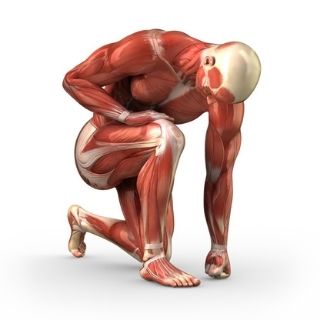Deep Tissue Massage in Albuquerque
But, Deep Tissue Massage is often misunderstood. The “Deeper is Better” mentality is no longer valid.
Deep Tissue Massage is one of the types of massage used in Sports Massage.
The effectiveness of “Deep Pressure” on muscles is great, but only with the right amount of pressure. Too much pressure can bruise the muscles and send you away with more pain to heal from than what you started with.
Too little pressure is what we call a “Fluff n Buff”. This is when you feel like a salad from the oil applied with feather like pressure. It’s like you wasted your entire hour getting sunscreen applied. Yuck.
An effective Deep Tissue Massage is somewhere in the middle.
How Mush Deep Tissue Pressure is The Right Pressure?
Though my office is often referred to as “Ruth’s House of Pain”, that doesn’t mean that clients leave bruised (anymore). What it does mean, is that finding the trouble spots often takes quite a bit of pressure and when The Spot is found, it can hurt a bit.
The trick is to find “The Spots”, which takes some pressure, and then to back off and relax every muscle around the area, and the muscles possibly being “recruited” to help the injured muscle(s). This pressure is medium at most.
When looking for a Massage Therapist who can give you an effective Deep Tissue Massage, look for at least 2 years of experience, and ask about their pressure. Newer therapists tend to think “Deeper is Better”, and you can hear it in the way they talk about the amount of pressure they can use. Just because you CAN GO DEEP, doesn’t make it effective.
As a Massage Therapist, there is no better learning tool to slap you in the face than seeing the bruises you caused on someone elses body….all the while believing that you were doing “good”, and seeing your client recovering from your “helpful” Deep Pressure.
How Deep is Too Deep With Massage?
Using deep pressure in the right way makes a WORLD OF DIFFERENCE in how the client will feel after the massage. Soreness after 2 hours is just not acceptable anymore.
As an athlete, if you can do your sport without pain 24 hours after a Deep Tissue Massage, then your Massage Therapist has done an excellent job. This knowledge of “correct pressure” takes many failed massages, bruised muscles and sore athletes.
This is why, having a Sports Massage or a Deep Tissue Massage with a new Massage Therapist RIGHT BEFORE an event is not recommended. Your Massage Therapist needs to learn how to help you, and you need to learn how to “Help them Help you” with clear communication.
They need to know how your body responds to the Deep Tissue pressure. Another tip, is that what pressure you ask for is often NOT what your body responds best to.
Learning the difference between what pressure a client asks for and what the client’s body calms down from is the key to an effective Deep Tissue, Sports Massage & Myofascial treatment.
Your therapist learns this difference not by guessing but by hours of experience of touching muscles in a state of contraction & spasm, then comparing it with the same muscles once they relax.
Benefits of Deep Tissue Massage
Deep Tissue Massage is very effective for the areas of our body with bigger muscle groups, and there are many benefits. This is why it is one of the favorite styles of massage used in Sports Massage.
Here are some of the benefits and areas of the body or conditions that Deep Tissue have helped in our office:
- Sciatic Nerve pain
- Hamstring pulls, strains, spasms
- Chronic neck and back pain
- Carpal Tunnel Syndrom
- Shoulder pain
- Tennis elbow/Golfers elbow
- Increases range of motion
- Aids in muscle injury recovery
- Improves posture
- Plantar fasciitis
When pain or tension is in the areas listed above, the best technique to start with for quick and long lasting results is Deep Tissue Massage.
The most profound benefits from deep pressure are on areas where the pain starts several muslce layers deep.
Light pressure and even stretching sometimes can’t influence the spasm or contraction in the deep layers.
It’s not the only way, though.
Deep Tissue Massage for Pain Relief
Deep Tissue Massage is one of the best modalities for pain relief, especially when it is combined with myofascial therapies, core synchronism for example.
A combination of several modalities is usually the a good remedy for the client’s muslces to relax in any situation.
The same is true with deep massage treatments.
The pain cycle can be stopped, which is amazing to witness.
Again, it’s not the deepest pressure that does this, instead, a combination of modalities.
Use of deep pressure until the specific area of pain is discovered, then less pressure and attention to surrounding areas is a great place to start.
Come back to the SPOT and check if the spasm or pain is less, and start the process again.
The depth of pressure should come on gradually, first warming up the tissues to prepare them for more aggressive pressure.
Another good practice is to have a stable hand on the opposite site of the pressure, if possible.
For example, when working on one side of the shoulder blade, holding pressure on the opposite side of the scapula can keep pressure steady for the “pressured” area while keeping surrounding tissue from being manipulated.
This can help determine which other muscles are involved with the muscle “under pressure.” Some of the surrounding tissue can react to the pressure, which can be an indication (or hint) of a movement or pain pattern.
Next, put pressure on the muscle (or tissue) which responded to the original pressure and continue this process until the reaction from surrounding tissues stops.
For example: as you are working on the tissues on the lateral aspect or outer edge of the shoulder blade, notice if the neck flinches, or the back muscles tighten, or the elbow squeezes into the body. These are just a few examples of responses.
Keep alert and notice with your hands and eyes areas that respond, then move there and repeat.
Hint: tissues FAR away could respond, where you would not expect, so keep your eyes peeled and use feather touch to feel mini spasms one muscle away or completely across the body.
You can do this on yourself! It takes mucho self-awareness and deep breathing, and you have to contort your body a bit to get to areas. But, it is possible.
Of course it’s way easier to have someone do it. 🙂
Call or text 505-332-9292 to schedule an appointment.

Join Our Newsletter
You will receive self-care tips, stretches, exercises, recipes, fun articles and other cool stuff sent to your inbox each week!

Did you know?
88% of consumers surveyed believe that massage can be effective in reducing pain
AMTA Consumer Survey Fact Sheet, read more…
Articles on
Deep Tissue Massage:
Everything You Need to Know About Deep Tissue Massage
by Cathy Wong for VeryWellHealth.com
What to Know About Deep Tissue Massage
by Beth Sissons for MedicalNewsToday.com
The Pressure Question in Massage Therapy
by Paul Ingraham for painscience.com
Benefits of Massage:
- Improves local circulation
- Decreases blood pressure
- Relaxes muscles
- Relieves insomnia
- Promotes positive mood
- Relieves anxiety and depression
- Maintains flexibility
- Reduces pain
- Assists in eliminating wastes
- Maintains healthy skin
- Improves nutrient supply to body
- Relieves stiff joints
-
More…
“25 Reasons to Get a Massage
-
- Relieve stress
- Relieve postoperative pain
- Reduce anxiety
- Manage low-back pain
- Help fibromyalgia pain
- Reduce muscle tension
- Enhance exercise performance
- Relieve tension headaches
- Sleep better
- Ease symptoms of depression
- Improve cardiovascular health
- Reduce pain of osteoarthritis
- Decrease stress in cancer patients
- Improve balance in older adults
- Decrease rheumatoid arthritis pain
- Temper effects of dementia
- Promote relaxation
- Lower blood pressure
- Decrease symptoms of Carpal Tunnel Syndrome
- Help chronic neck pain
- Lower joint replacement pain
- Increase range of motion
- Decrease migraine frequency
- Improve quality of life in hospice care
- Reduce chemotherapy-related nausea”

